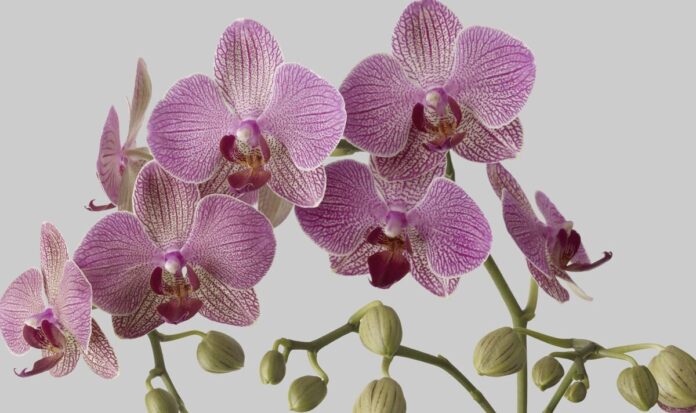With the exception of certain orchids like the ludisa, gardeners don’t generally grow these houseplants for their foliage. It’s frustrating to stare at an orchid every day like a pot waiting to boil, longing for flowers that never appear. It’s even more frustrating to watch an orchid develop buds that shrivel and drop without ever opening. Many issues that keep your orchids from thriving however, can be addressed with minor adjustments. The experts at rePotme Orchid Supplies have shared their top five reasons for orchids failing to bloom.According to the experts, ‘the most common reason’ that orchids fail to bloom is insufficient light. They said: ‘The Phalaenopsis and Paphiopedilum orchids are usually happy with the filtered light in a windowsill but many other varieties need more light than that.’Dendrobium, cattleya, oncidium and other medium to high light orchids may need supplementary grow lights or time spent outdoors in the summer to get the kind of light levels they require to bloom. The plant pros explained: ‘Orchids are not like tomato plants, the vast majority cannot handle full sun. Dappled shade is ideal and even though a bright window seems like more light than outdoor shade, it is not.’As an orchid gets more light its leaves turn a lighter shade of green. Very light yellow-green leaves usually indicate too much light where very dark forest green leaves can indicate too little light. In summary, if you have a dendrobium, cattleya, oncidium, Cymbidium, vanda, brassia or other high light orchid growing indoors on a windowsill and it has not bloomed in a year or two, chances are a lack of sufficient light is the reason.’For those who own orchids that require high light, the experts advised putting them in a vanda basket hanging from a tree branch. They explained: ‘Higher humidity supplemented with sufficient watering allows high light orchids to have a vigorous growth season. We’ve seen dendrobiums rebloom with this kind of treatment even after they have languished without blooming on a windowsill for ages. The key to getting the bloom was more light.’READ MORE: Gardening expert warns against ‘detrimental’ autumn mowing mistake ‘Most common reason’ orchids failing to bloom – how to encourage an ‘abundance of flowers’ (Image: GETTY)Good roots bring good blooms. The houseplant experts warned that an orchid may have deceptively beautiful leaves with a root system that is in ‘dire trouble’. Often root trouble is the result of overwatering or lack of repotting. Orchid roots need oxygen to survive and without it they smother. The media that orchids are potted in is not like the dirt that traditional houseplants are potted in. The experts said: ‘Even the best orchid mix breaks down over time and requires replacement. Often, the fear of the repotting process will cause people to leave an orchid in the mix for far too long. This may be preventing the orchid from having enough stored strength to bloom.’The selection of a top quality orchid mix is of the utmost importance. Don’t be fooled by generic orchid mixes sold at hardware stores. When it comes to orchid mixes, quality and freshness really matter. Once you see for yourself the difference a fresh mix from the highest quality ingredients makes compared to store brands you won’t ever want to go back to those inferior mixes again.’Watching an orchid carefully can give clues to trouble at the root zone – this is why it is important to keep them in clear pots. The orchid experts noted: ‘When we buy orchids at the store they are typically quite young. Over time each new leaf or pseudobulb should be bigger than the previous one or at least the same size. This determination can typically be made when the next new leaf or pseudobulb begins to form, or the plant goes into its bloom cycle.’DON’T MISS’Biggest reason’ mice enter homes – ‘effective’ methods to deter them [EXPERT]’Permanently kill weeds’ using three ‘everyday household items’ [TIPS]Remove foul ‘musty smells’ from your home with ‘effective’ methods [COMMENT] An orchid may have deceptively beautiful leaves with a root system that is in ‘dire trouble’ (Image: Getty) According to the pros, each orchid type has a time of the year when it naturally will bloom (Image: Getty)Many orchids bloom once per year, some twice or even more. Once in bloom some flowers last weeks or months while others can last only days. Some basic research about the type of orchid will identify what to expect. For example, Phalaenopsis orchids usually bloom once per year and the blooms can last for months. Once the flowers fall off it may have a couple of extra flowers emerge from the end of the bloom spike (or branch of that spike) and bloom again. If lots of long-lasting blooms are the goal, then phalaenopsis is a satisfying orchid to grow. Cattleya, oncidium and dendrobium usually bloom once or maybe twice per year with spectacular blooms that last a month or two.5. Natural stimuli In nature, orchids have natural stimuli that indicate to the plant that the growth season is over and it’s time to bloom. Some orchids are temperature sensitive and some are light sensitive. The experts said: ‘Those that are temperature sensitive are often triggered to bloom by the natural cooling that occurs in autumn. This drop in temperature signals to the orchid that the growth period is coming to an end and it is time to get ready to set a bloom spike. Sometimes orchids grown in our homes where the temperature is fairly constant are deprived of this natural cue and will be reluctant to bloom.’Temperatures around 15 degrees for a brief period (one to two weeks) are usually sufficient to initiate a bloom spike in the majority of phalaenopsis. Similarly, light sensitive orchids grown in homes where lights are on after dark can have their natural cycle disrupted. For the types of orchids that can be kept outdoors in summer, they will usually sense the shortening days and begin the bloom cycle.


